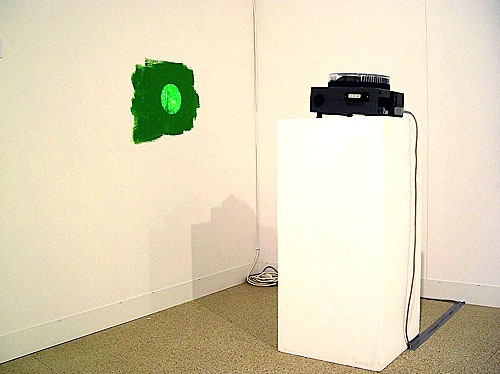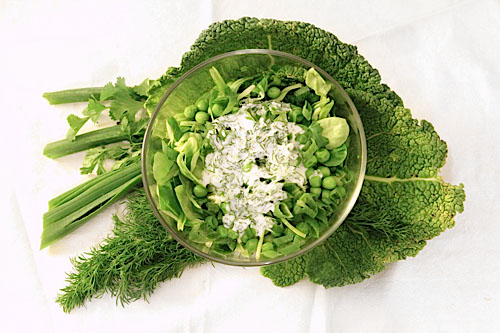Green is one of the most abundant colors; there are greens in every imaginable shade and tone throughout the world’s natural landscapes. From green algae to rainforest canopies, green permeates and dominates in its diversity. Individual greens are often blurred as countless plants merge into a color field, many overlapping green leaves forming the density of forests or millions of blades blending to become a sports field’s smooth surface. The simultaneous layering and highlighting that is seen in nature can be compared to the artwork of Jonathan Monk, who’s layering of meaning and medium fuse together history, critique, and technique. Monk’s 2002 work, Green with hidden Noise combines a single solid swath of green painted roughly on a white wall with a slide projection focused directly atop this patch of color. The circular projection itself appears to depict a green scene: a forest of trees? The composition is green on green.

slide installation and wall painting, image courtesy Meyer Riegger, Karlsruhe and Berlin
While the work literally layers color and medium: green paint on a white wall and a green photographic slide projection, it also layers reference. Quoting Marcel Duchamp’s 1916 work, With Hidden Noise, which consists of two brass plates sandwiching a mass of string said to house an unidentified object, Monk’s titling provides referential cues. The “noise” that Duchamp references is the sound the concealed object would make when interacted with. Within Monk’s work, the noise may be something more like TV static, the irritation of a noisy image, the blurring of vision.

Like Green with hidden Noise, this Greens recipe recombines raw materials, or sources as it were. Within both, it is particularly the act of overlapping and combination that creates value. Here a Turkish inspired salad is given a new spring twist. By using all green ingredients, the subtle changes in texture and taste make each bite pop and stand out within the recipe’s single color palette. In this sense it is a study in flavor and perception inviting those feasting, like Monk’s audience, to take time to distinguish one piece from the whole. Use only fresh ingredients and you will see the forest for the trees – each crisp bite bringing together a true harbinger of spring!

Greens Salad
For the perfect pairing, serve with fresh homemade falafel and hummus.
Yield: 4 servings
4 generous cups baby field salad
1 cup fresh green peas, steamed and cooled (thawed if frozen)
½ cup green onion, chopped thinly
½ cup fresh cilantro (coriander), chopped finely
½ large cucumber, sliced thinly
Dressing
1 cup mild yogurt
juice from ½ of one large lemon
1 Tablespoon honey
2 Tablespoons fresh dill, chopped finely
Rinse and spin dry the baby field salad, taking care to trim off the roots. Layer together in a large serving bowl: salad, green peas, green onion, fresh cilantro, cucumber slices, repeat!
Mix together in a small dish: yogurt, lemon juice, honey and fresh dill.
Refrigerate until use.
Add the dressing and toss salad just before serving.
Cassandra Edlefsen Lasch is a Berlin-based art historian and artist advisor active within international contemporary art production and project realisation. Investigating collaboration is central to her work and her recipes are all gluten-free.
………………………………………………..

6 comments
sally says:
Mar 22, 2011
Love the green on green salad! I imagine it would be very tasty with falafel and hummus.
Rosa says:
Mar 22, 2011
What a lovely salad! So vibrant in color. Spring in a bowl.
Cheers,
Rosa
cha sen says:
Mar 23, 2011
Thought provoking piece. Thank you.
Joanne says:
Mar 23, 2011
I adore the color green and it’s probably because of all the associations it has with spring. This vibrantly colored salad is also so vibrantly flavorful!
Julie says:
Mar 24, 2011
Beautiful piece.
erin says:
Apr 3, 2011
Love that the inspiration for this one came from a nonfood-related piece. So creative and lovely!